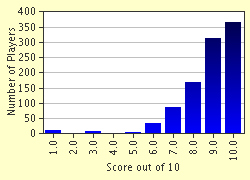Quiz Answer Key and Fun Facts
1. If you know what to look for, a duck can be distinguished from a cat without difficulty. In the "Jaw Test", one carefully inspects the two animals, looking for a well defined lower jaw. Which does not have one?
2. Another simple method for telling which of two animals is a duck and which is a cat is to perform the "Nostrils-In-The-Air Test". Locate the nostrils or nares of the two animals. The nostrils that point up belong to which animal?
3. The "Flotation Test" is another method for differentiating cats from ducks. Slowly and gently place the two test animals in water. Which will float higher?
4. Having performed the "Flotation Test" in which one attempts to discriminate between a duck and a cat by seeing which floats highest, one may observe the specimens for "post-flotation tail lashing". Which animal is LESS likely to be lashing its tail?
5. The "High Toss Maneuver" will often reliably distinguish between ducks and cats. This method requires assistance. Standing on springy turf, on the count of three, you and your assistant should launch both animals as high into the air as possible and stand back. Which animal is more likely to fly away?
6. Both ducks and cats are fond of fish. In the "Thirty Day Meal Rejection Test", one places identical portions of fish in front of the two animals twice daily and notes the animals' behavior. Which animal is more likely to sniff the food and walk away, nose in the air, without eating it? (Hint: Which animal actually has a nose?)
7. Utilizing stealth and a glass of water one can perform the "Back Run Off" to tell which of two animals is the duck and which is the cat. Carefully sneak up on the test animal and pour four ounces of water onto the test subject's back. Which animal will have retained more moisture in the area that the stream of water impacted?
8. "The Can Opener Test" will usually distinguish between a duck and a cat. Place the two animals in a room as far distant from the kitchen as possible. Run the electric can opener. Which animal will likely appear in the kitchen first?
9. The "Surrogate Determination Method" takes advantage of the fact that most three year olds can distinguish between ducks and cats with ease. Show pictures one at a time to a three year old, pointing to the picture and saying, "What does she (or, if you prefer, he) say?" The picture of which animal will elicit a "quack"?
10. Those of you who have mastered the subtleties of animal emotional expression may wish to attempt "The Pillow Test" as a way of telling a duck from a cat. Hold up a down pillow in view of both animals. Which of the two will look at you reproachfully?
Source: Author
uglybird
This quiz was reviewed by FunTrivia editor
crisw before going online.
Any errors found in FunTrivia content are routinely corrected through our feedback system.


